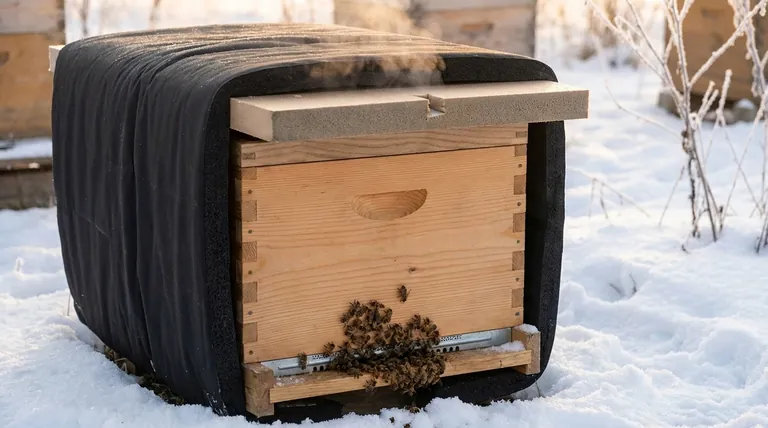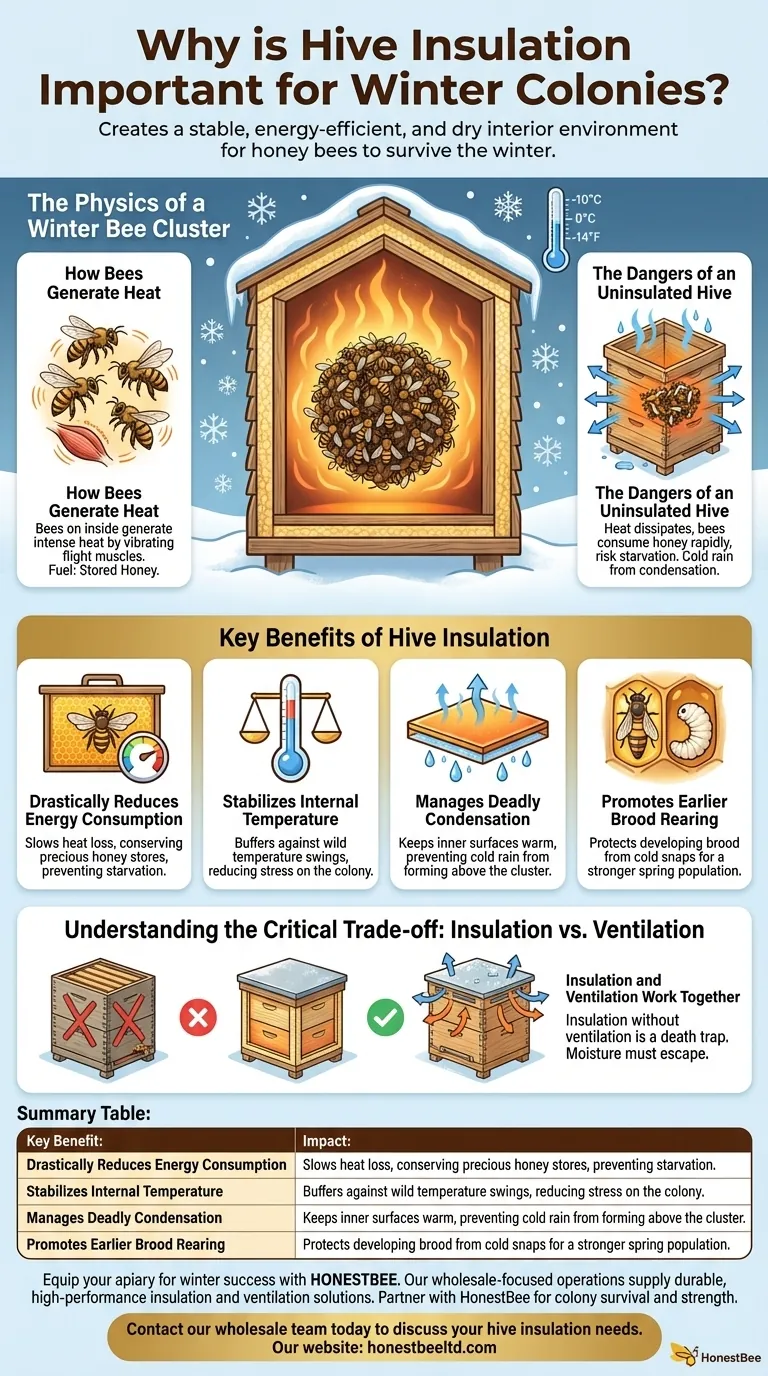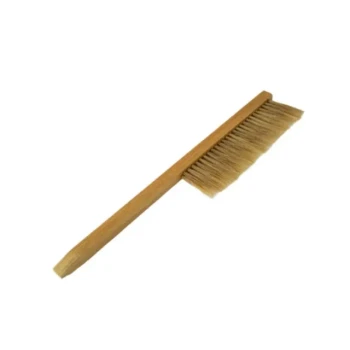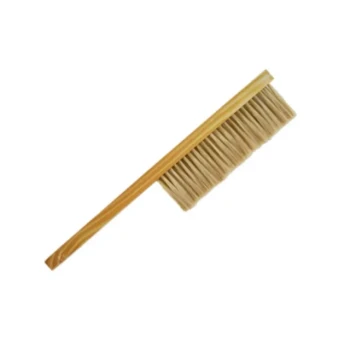To be direct, hive insulation is crucial because it creates a stable, energy-efficient, and dry interior environment for honey bees to survive the winter. It’s not just about keeping bees warm; it’s about reducing the immense stress and energy expenditure they face when battling cold temperatures, temperature swings, and deadly internal moisture.
The single greatest role of hive insulation is to reduce the amount of honey the bees must consume to survive. By slowing heat loss, you enable the colony to conserve its precious winter food stores, which is the most critical factor in preventing starvation and ensuring their spring survival.

The Physics of a Winter Bee Cluster
To understand why insulation is so effective, you must first understand how a honey bee colony functions in the cold. They are not passive occupants; they are an active superorganism generating their own heat.
How Bees Generate Heat
Honey bees do not heat the entire hive cavity. Instead, they form a tight winter cluster around their queen.
Bees on the inside of this cluster generate intense heat by vibrating their flight muscles without moving their wings. The bees on the outer layer of the cluster act as a living blanket, insulating the core.
The fuel for this heat generation is their stored honey. The colder it is, the more honey they must consume to maintain the cluster's core temperature.
The Dangers of an Uninsulated Hive
A standard wooden Langstroth hive is a relatively thin box with poor insulating properties, often compared to living in a wooden tent.
Without insulation, the heat generated by the cluster dissipates rapidly into the cold air. This forces the bees to burn through their honey stores at an accelerated rate, risking starvation before spring.
Furthermore, rapid temperature swings on sunny days followed by frigid nights cause the cluster to constantly expand and contract, adding significant stress to the colony.
Key Benefits of Hive Insulation
Properly insulating a hive addresses the primary threats a colony faces during winter: starvation, moisture, and stress.
Drastically Reduces Energy Consumption
The most immediate benefit of insulation is slowing down heat loss. This directly reduces the amount of honey the bees need to consume to stay warm.
A colony in an insulated hive, such as a polystyrene hive or a wrapped wooden hive, conserves its food stores far more effectively, making it the single best defense against winter starvation.
Stabilizes Internal Temperature
Insulation acts as a buffer against the wild temperature fluctuations of winter. It moderates the internal environment, protecting the bees from both bitter cold and sudden thaws.
This stability reduces stress on the colony, allowing the cluster to maintain its ideal temperature without constantly expending energy to adjust its size and heat output.
Manages Deadly Condensation
As the bee cluster respires and metabolizes honey, it produces warm, humid air. In a cold, uninsulated hive, this moist air rises and hits the frigid inner cover.
When this happens, the moisture condenses and drips back down as freezing cold water onto the cluster below. This "cold rain" is often fatal to the bees.
Insulation (especially on the top of the hive) keeps the inner surfaces warmer than the dew point, preventing this condensation from forming directly above the bees and allowing moisture to be properly ventilated.
Promotes Earlier Brood Rearing
As early as January, the queen begins to lay eggs to build the colony's population for spring. This developing brood must be kept at a consistent, warm temperature.
Insulation protects this vulnerable new brood from late-season cold snaps, allowing the colony to build up its numbers earlier and emerge stronger for the first spring nectar flows.
Understanding the Critical Trade-off: Insulation vs. Ventilation
Applying insulation without considering ventilation is one of the most common and fatal beekeeping mistakes.
Insulation and Ventilation Work Together
An insulated hive is not an airtight container. Insulation without ventilation is a death trap.
The moisture produced by the bees must have a way to escape. Without an escape route, the hive will become a damp, moldy environment, leading to disease and colony death.
The Goal: A Warm, Dry Hive
The ideal setup involves wrapping the hive body and, most importantly, placing a thick layer of rigid foam insulation on top. This is paired with a small upper entrance or a dedicated "quilt box."
This system keeps the heat in while allowing the excess water vapor to rise and exit the hive, creating the warm and dry conditions necessary for winter survival.
How to Apply This to Your Hive
Your approach to insulation should be based on your climate and your goals for colony health.
- If your primary focus is survival in a very cold climate: Fully wrapping the hive bodies and using a thick layer of top insulation combined with a moisture management system (like a quilt box) is essential.
- If your primary focus is simplicity in a moderate climate: Even a simple hive wrap and a piece of foam insulation placed over the inner cover can dramatically improve the colony's energy efficiency.
- If your primary focus is preventing moisture issues: Prioritize top insulation. Keeping the ceiling of the hive warm is the single most effective way to prevent lethal condensation from raining down on the cluster.
Ultimately, a well-insulated and properly ventilated hive empowers the colony to manage its own environment, which is the foundation of successful wintering.
Summary Table:
| Key Benefit | Impact on the Colony |
|---|---|
| Reduces Energy Consumption | Slows heat loss, conserving honey stores and preventing starvation. |
| Manages Condensation | Prevents "cold rain" from forming and dripping onto the cluster. |
| Stabilizes Internal Temperature | Buffers against temperature swings, reducing stress on the bees. |
| Promotes Earlier Brood Rearing | Protects new brood from cold snaps for a stronger spring population. |
Equip your apiary for winter success with HONESTBEE.
Our wholesale-focused operations supply commercial apiaries and beekeeping equipment distributors with the durable, high-performance insulation and ventilation solutions detailed in this article. By partnering with HONESTBEE, you ensure your colonies have the tools they need to conserve energy, manage moisture, and emerge stronger in the spring.
Contact our wholesale team today to discuss your hive insulation needs and ensure your colonies' winter survival.
Visual Guide

Related Products
- Inner Beehive Cover for Beekeeping Bee Hive Inner Cover
- Professional Galvanized Hive Strap with Secure Locking Buckle for Beekeeping
- Professional Drop-Style Hive Handles for Beekeeping
- Premium Comfort Grip Spring-Loaded Hive Handles
- Professional Grade Foldable Beehive Handles
People Also Ask
- What is the role of inner covers in insulated beehives? Master Moisture Control for a Healthy Colony
- What is the function of an inner cover in a beehive? Essential for Hive Health & Management
- Why might beekeepers use an inner cover under the telescoping outer cover? Simplify Hive Management & Protect Your Colony
- What are the advantages of using an inner cover in a beehive? Key Benefits for Hive Health & Beekeeper Efficiency
- What is the function of the center hole in the inner cover? Master Hive Ventilation and Feeding



















